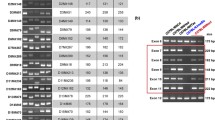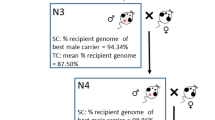Abstract
Unclear or misclassified genetic background of laboratory rodents or a lack of strain awareness causes a number of difficulties in performing or reproducing scientific experiments. Until now, genetic differentiation between strains and substrains of inbred mice has been a challenge. We have developed a screening method for analyzing inbred strains regarding their genetic background. It is based on 240 highly informative short tandem repeat (STR) markers covering the 19 autosomes as well as X and Y chromosomes. Combination of analysis results for presence of known C57BL/6 substrain-specific mutations together with autosomal STR markers and the Y-chromosomal STR-haplotype provides a comprehensive snapshot of the genetic background of mice. In this study, the genetic background of 72 mouse lines obtained from 18 scientific institutions in Germany and Austria was determined. By analyzing only 3 individuals per genetically modified line it was possible to detect mixed genetic backgrounds frequently. In several lines presence of a mispairing Y chromosome was detected. At least every second genetically modified line displayed a mixed genetic background which could lead to unexpected and non-reproducible results, irrespective of the investigated gene of interest.


Similar content being viewed by others
References
Bourdi M, Davies JS, Pohl LR (2011) Mispairing C57BL/6 substrains of genetically engineered mice and wild-type controls can lead to confusing results as it did in studies of JNK2 in acetaminophen and concanavalin A liver injury. Chem Res Toxicol 24(6):794–796
Bryant CD, Zhang NN, Sokoloff G, Fanselow MS, Ennes HS, Palmer AA, McRoberts JA (2008) Behavioral differences among C57BL/6 substrains: implications for transgenic and knockout studies. J Neurogenet 22(4):315–331
Case LK, Teuscher C (2015) Y genetic variation and phenotypic diversity in health and disease. Biol Sex Differ 6:1–6
Fischer M, Kosyakova N, Liehr T, Dobrowolski P (2017) Large deletion on the Y chromosome long arm (Yq) of C57BL/6JBomTac inbred mice. Mamm Genome 28(1–2):31–37
Hooper M, Hardy K, Handyside A, Hunter S, Monk M (1987) HPRT-deficient (Lesch-Nyhan) mouse embryos derived from germline colonization by cultured cells. Nature 326(6110):292–295
Huang TT, Naeemuddin M, Elchuri S, Yamaguchi M, Kozy HM, Carlson EJ, Epstein CJ (2006) Genetic modifiers of the phenotype of mice deficient in mitochondrial superoxide dismutase. Hum Mol Genet 15(7):1187–1194
Mahajan VS, Demissie E, Mattoo H, Viswanadham V, Varki A, Morris R, Pillai S (2016) Striking immune phenotypes in diverse gene-targeted mice are driven by a copy number variant originating from a commercially available C57BL/6 strain. Cell Rep 15(9):1901–1909
Mattapallil MJ, Wawrousek EF, Chan CC, Zhao H, Roychoudhuri J, Ferguson TA, Caspi RR (2012) The Rd8 mutation of the Crb1 Gene is present in vendor lines of C57BL/6N mice and embryonic stem cells, and confounds ocular induced mutant phenotypes. Invest Ophtalmol Vis Sci 53(6):2921–2927
Nelson VR, Spiezio SH, Nadeau JH (2010) Transgenerational genetic effects of the paternal Y chromosome on daughters’ phenotypes. Epigenomics 4:513–521
Pettitt SJ, Liang Q, Rairdan XY, Moran JL, Prosser HM, Beier DR, Lloyd KC, Bradley A, Skarnes WC (2009) Agouti C57BL/6N embryonic stem cells for mouse genetic resources. Nat Methods 6(7):493–496
Pulverer B (2015) Reproducibility blues. EMBO J 34(22):2721–2724
Specht CG, Schoepfer R (2004) Deletion of multimerin-1 in alpha-synuclein-deficient mice. Genomics 83:1176–1178
Zurita E, Chagoyen M, Cantero M, Alonso R, Gonzales-Neira A, Lopez-Jimenez A, Lopez-Moreno JA, Landel CP, Benitez J, Pazos F, Montoliu L (2011) Genetic polymorphisms among C57BL/6 mouse inbred strains. Transgenic Res 20:481–489
Acknowledgements
Tissue samples of reference inbred strains were kindly provided by Dr. Thomas Grunwald. We thank Dr. Olaf Gelsen for critical reading of the manuscript. This work was supported by the European Regional Development Fund (EFRE Project No. 100210585).
Author information
Authors and Affiliations
Corresponding author
Ethics declarations
Conflict of interest
P. Dobrowolski is in an employment relationship with GVG Genetic Monitoring. M. Fischer was charged by GVG Genetic Monitoring to perform STR-analysis.
Electronic supplementary material
Below is the link to the electronic supplementary material.
Rights and permissions
About this article
Cite this article
Dobrowolski, P., Fischer, M. & Naumann, R. Novel insights into the genetic background of genetically modified mice. Transgenic Res 27, 265–275 (2018). https://doi.org/10.1007/s11248-018-0073-2
Received:
Accepted:
Published:
Issue Date:
DOI: https://doi.org/10.1007/s11248-018-0073-2




